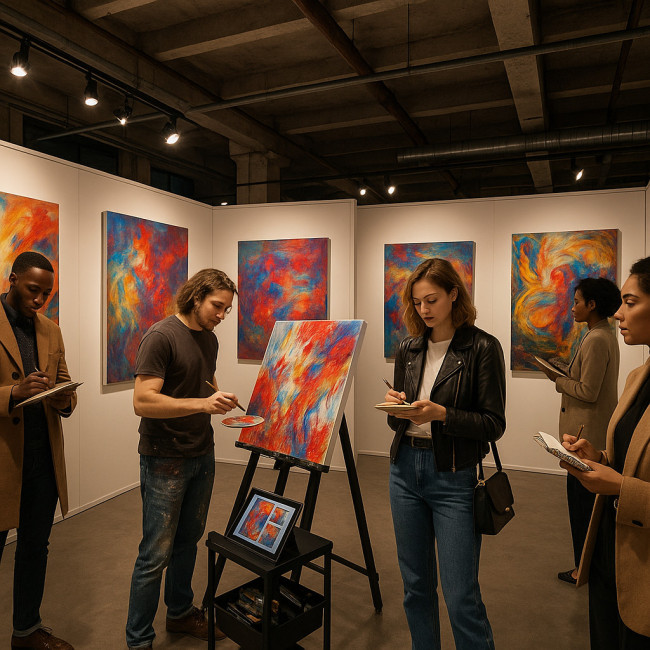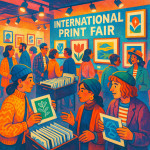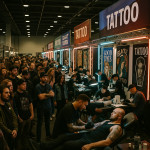Painter pop-up events: portfolio demo tricks to attract gallery scouts
Want gallery scouts to chase you instead of the other way around? A strategically planned painter pop-up event can turn a single afternoon into weeks of follow-up meetings. In this guide you'll learn how to design an irresistible demo space, spark meaningful conversations and walk away with concrete opportunities.
Why painter pop-up events work in 2024
Pop-up culture has migrated from retail to fine art. According to the Art Basel & UBS Art Market Report 2023, galleries sourced 19 % of new artists through temporary events last year—up from 11 % in 2019. The short-term nature creates urgency, while the informal ambiance gives scouts a low-risk way to evaluate emerging talent.
- Scarcity triggers action: a 48-hour viewing window prompts quicker buying decisions.
- Low overhead: you can test a new city without committing to a six-week exhibition.
- Data capture: visitor check-ins feed your mailing list for future launches.
Set one clear objective
Start by choosing the single result that will define success. Options include:
- Securing three studio visits with target galleries
- Selling five original pieces on the day
- Collecting 200 newsletter sign-ups for an upcoming series drop
All layout and marketing choices flow from that objective. For example, if you aim for studio visits, dedicate wall space to process sketches to tease long-term potential.
Pick a venue scouts already frequent
Hotel lobbies during art fairs, co-working foyers near design districts or even concept stores with art corners all attract roaming curators. Use location-filtered artist listings to check whether previous pop-ups drove footfall in your niche.
Venue checklist
| Criterion | Minimum standard | Pro tip |
|---|---|---|
| Lighting | 500 lux, CRI > 90 | Add clamp lights to avoid green cast |
| Wall finish | Neutral grey or white | Hang lightweight foam board if venue walls are coloured |
| Ceiling height | 2,8 m+ | Allows large canvases and vertical signage |
| Foot traffic | 200+ daily visitors | Place QR codes at both entrances to funnel scans |
Design a portable portfolio demo station
Gallery scouts may only linger five minutes. A modular station ensures they see the best of your work instantly.
Elements that convert
- Rotating easel: Display a hero painting and swap every hour to reward return visits.
- Tablet slideshow: 30-second loops incorporating high-resolution images optimised via the painter SEO playbook.
- Material sampler: Invite scouts to touch pigment swatches mounted on a small board.
- Process reel: A silent 4K video of brushstrokes gives insight into craftsmanship.
Pre-event buzz tactics
Start outreach three weeks before opening.
Scouts rarely attend events they hear about the same week—give them calendar space and FOMO in equal measure.
- Email personalised invites referencing the scout's recent acquisitions.
- Embed a 15-second teaser clip and a Save-the-date file.
- Schedule two reminder posts on Instagram and LinkedIn.
- Send a final SMS alert 24 hours ahead for confirmed RSVPs.
Need a full timeline? Review the annual art-event roadmap.
Live engagement: talking to gallery scouts
Carry a small notebook with pre-qualified questions:
- “Which medium sells fastest for your collectors right now?”
- “Are you looking for thematic shows next season?”
- “Which price range moves quickest in your space?”
Listen first, then tailor your pitch. When handing over a print catalogue, mark two works that align with their answers.
Capture data without awkwardness
- Place a NFC tag beside each piece—one phone tap opens your digital catalogue.
- Offer a postcard featuring a work-in-progress sketch in exchange for an email address.
After-event follow-up workflow
Speed matters. Aim to send personalised recap emails within 48 hours.
- Day 1: Thank-you note + high-res images of pieces the scout viewed.
- Day 3: Studio visit invitation with three available dates.
- Day 7: Limited-time print offer to keep momentum.
You can automate reminders using free CRM tools mentioned in the article on live-painting bookings.
Measuring ROI of a painter pop-up
- Conversion rate: scouts contacted vs studio visits booked.
- Average sale value: track originals, prints and commissions separately.
- Mailing-list growth: segment by collector, curator, press.
- Social reach: use unique hashtags to count reposts.
Source : Google Trends
Common mistakes to avoid
- Overcrowded walls: show six to eight works max; more overwhelms visitors.
- No price visibility: scouts hate guessing. Discrete wall labels work.
- Ignoring lighting tests: always arrive an hour early to adjust hotspots.
- Delayed responses: a week of silence can kill hard-won interest.
Boost credibility with storytelling assets
A pop-up is the perfect stage to trial your next series statement that hooks curators. Print a concise manifesto and place it near the entrance. Scouts remember narratives more than technical specs.
Are you pop-up ready? – Quick quiz
FAQ
- Do I need to insure artworks during a pop-up?
- Yes. Short-term event insurance covering transit and on-site damage typically costs 1–2 % of the total artwork value.
- What is the optimal pop-up duration?
- Two to three days maximise urgency and reduce venue fees while allowing enough time for word-of-mouth to spread.
- Should I offer prints or only originals?
- Offer limited-edition prints under €500 to engage new collectors without diluting the value of originals.
- How early should I start marketing?
- Begin at least three weeks out to secure calendar space and build anticipation through drip campaigns.
Next step: turn momentum into long-term visibility

Your pop-up isn't the finish line; it's the launch pad. Update your online gallery within 24 hours, post a recap reel and nurture new contacts. When done right, painter pop-up events become a repeatable engine that feeds both sales and invitations to larger exhibitions.
Ready to sketch your own pop-up blueprint? Start mapping dates and venues today, and let your work speak face-to-face with the people who can propel your career.











